PRIVATE MEMBERS’ BUSINESS
[Private Members’ Business]
Heritage Lighthouse Protection ActThe House proceeded to the consideration of Bill S-215, An Act to protect heritage lighthouses, as reported (with amendments) from the committee.The Acting Speaker (Mr. Royal Galipeau):
There being no motions at report stage, the House will now proceed without debate to putting the question on the motion to concur in the bill at report stage.Mr. Larry Miller (Bruce—Grey—Owen Sound, CPC)
moved that Bill S-215, as amended, be concurred in.The Acting Speaker (Mr. Royal Galipeau):
Is it the pleasure of the House to adopt the motion?Some hon. members: Agreed.
Some hon. members: On division.
The Acting Speaker (Mr. Royal Galipeau): I declare the motion carried.
(Motion agreed to)
The Acting Speaker (Mr. Royal Galipeau):
When shall the bill be read a third time? By leave now?
Some hon. members: Agreed.
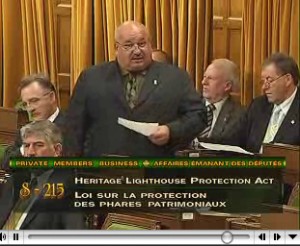 Mr. Larry Miller Mr. Larry Miller
moved that the bill be read a third time and passed.
He said: Mr. Speaker, it is a great pleasure to rise in the House today to debate third reading of Bill S-215, an act to protect heritage lighthouses. But before I go any further, I would like to personally thank my seconder, the member for South Shore—St. Margaret’s, for all his hard work on this, and also for the very strong support from the Minister of Fisheries and Oceans, the member for St. John’s South—Mount Pearl.
I would be remiss if I did not mention some of the history of this bill which some may or may not know. This initiative was initiated seven or eight years ago by the late Senator Forrestall. After his unfortunate passing, it was carried on by Senators Carney and Murray. We have had some great support from people all over the country which I will be talking about a little further here.
There is a book called Alone in the Night. It is a collection of stories about the lighthouses of Georgian Bay, where I happen to live, the Manitoulin Islands and the North Channel in Ontario. It speaks about what our Canadian lighthouses really are when the authors wrote:
Lighthouses capture the imagination. There is an obvious appeal in the romantic image of lights as beacons of strength and protection, but the fascination goes beyond that. Pass one of the silent towers and an eerie presence beckons–of untold stories and forgotten memories.
By most standards, we are still a very young country. Lighthouses are a critical and important part of our early history and our development as a nation. From Newfoundland and Labrador to British Columbia, they have shaped our destiny. Let me offer but a few selected samples.
The Cape Pine light tower, which is a national historic site, was built in 1851 on Newfoundland’s southernmost point to guide transatlantic navigation. It was the first of a series of cast iron structures that substituted for fire-prone timber structures. On a personal note, I had the privilege of being at that site last July and it is truly something to see. Its contribution continues today. In recent years it has operated as a pollution research station.
In the Maritimes, we have Sambro Island, just outside the entrance to Halifax Harbour. It is 250 years old this year and the oldest operating lighthouse in all of the Americas. Along the St. Lawrence, L’Isle-Verte and Cap-des-Rosiers lighthouses were built almost 200 and 150 years ago respectively, and both are designated national historic sites. In British Columbia, Race Rocks and Fisgard light stations will be 150 in 2010.
All members know of the important role that lighthouses have played in our development as a nation. With many lighthouses celebrating important anniversaries this year, and I have mentioned just a couple of them, I can think of no better way to honour their importance than for this House to pass Bill S-215.
The fact that this bill has arrived at third reading speaks to the tremendous amount of thought that this House and the Senate have put into protecting our heritage lighthouses. In fact, it is the seventh time that Parliament has considered a bill to protect heritage lighthouses, and I sincerely hope we will be seventh time lucky. Going back to my Irish roots, maybe the luck of the Irish will be upon us here.
There is broad support for this bill in this House, in the Senate, and certainly among Canadians. To date we have spent a considerable amount of time on this bill, with many hours in committee listening to Canadians voice their support for protecting heritage lighthouses. We heard from the Senate, Department of Fisheries and Oceans, Parks Canada, and from academia and community stakeholders on both coasts, in central Canada and Quebec. We have heard the voices of people across this country urging us to pass this legislation and I agree with them.
I can tell members that in my riding of Bruce–Grey–Owen Sound, there are a number of lighthouses, including some of the six historic imperial lighthouses that were constructed between 1855 and 1859, but the condition of some of those majestic properties has deteriorated. I would like to see this bill passed to spare a similar fate to the one on Griffith Island in Georgian Bay, which is in my riding.
Just this past Saturday night I had the pleasure of being on the Chi-Cheemaun, a local Ontario Northlands ferry, where a fundraiser was held, and part of the tour that we had passed by Griffith Island.
(1745)
While it was very nice to see it at dusk, the light tower standing there with the light is great, but some of the outbuildings have deteriorated. This bill will keep that from happening and hopefully as well to some other important lighthouses in the country.
Why should we pass this bill? Mr. Robert Square, the chair of the Cove Island Lightstation Heritage Association, which is another lighthouse in my riding, said it best:
I believe that the preservation of lighthouses, Bill S-215, is a shared responsibility, shared between the government and our groups, the non-profits. There’s a wonderful opportunity here to do some really good work in preserving our lighthouses.
These sentiments were echoed by Mr. David Bradley, chair of the Association of Heritage Industries of Newfoundland and Labrador. In his testimony, he said:
Canada’s cultural heritage is vital to our identity and sense of place. The built heritage is the most vivid physical representation of that cultural heritage–
He also told the committee:
As with railway stations, lighthouses have a special significance to Canadians. They are iconic structures. Many have significant architecture. But their importance stems more from their role in Canadian history. Often standing in relative isolation on islands or headlands, they have been the first evidence of Canadian culture encountered by generations of immigrants to this country.
Natalie Bull also appeared before the committee as executive director of the Heritage Canada Foundation. She noted that lighthouses are used extensively in promoting tourism and that many are, as she put it, significant destinations in and of themselves. Peggy’s Cove, I think, is one that truly represents that.
Mr. Barry MacDonald, who has worked tirelessly to advance this initiative, spoke to the committee of the bonds that maritime communities have with the lighthouses that served them and their forebearers. He is the president of the Nova Scotia Lighthouse Preservation Society and he also noted how volunteer groups are benefiting their community by keeping these bonds intact. He said:
A pioneering effort began in Prince Edward Island in 1984 with the lease of the West Point lighthouse. A well-organized development plan saw ten rooms, a full-menu restaurant, and a gift shop in place by 1987. A real success story, this lighthouse has consistently employed 25 local people and is a major tourism destination on Prince Edward Island.
Casting an eye to New Brunswick, Mr. MacDonald pointed out that the interpretive centre at the Cape Enrage lightstation welcomes more than 40,000 visitors per year to the rugged Fundy shore. The non-profit group that developed it and operates it generates annual revenues of $350,000 and employs about 20 students. This group has been in business since 1993 and has not looked back.
The committee heard time and again of the tremendous benefits to transferring lighthouses to communities. It allows those closest to these heritage sites, those with the greatest stake in their preservation, a chance to have a hand in their future. Non-government groups have more flexibility in fundraising than does a government organization.
The executive director of Heritage B.C., Mr. Rick Goodacre, also appeared before the committee. He noted the contribution of the many volunteers who are adopting and will adopt lighthouses for alternate use. He stressed that the sustainability of lighthouses is dependent on the will to conserve them. He said of Bill S-215:
I think that’s why, in this case, special legislation is valuable and necessary. I don’t believe the general blanket of federal policy for heritage buildings is sufficient to deal with our historic lighthouses.
I say amen to that.
Mr. Goodacre told the committee that if Bill S-215 is passed, his organization will strive to help implement it in his province and realize its goal of protecting heritage lighthouses. To quote him: “We’ll do whatever we can to make this work”.
The witnesses who came before the committee clearly gave Bill S-215 a lot of thought. They recognized that while perhaps not every lighthouse can be saved, they are willing to work with the Government of Canada on this. They ask that we pass this bill so they can continue to be part of the process. They want to ensure that local communities are included and can assist in ensuring the future of their lighthouses.
Speaking on behalf of the heritage community on the east coast, Mr. Bradley, who again, is the chair of the Association of Heritage Industries of Newfoundland and Labrador, said:
–the heritage community recognizes that the compromises made along the way were a necessary part of that process, and we are happy with this bill.
(1750)
Barry MacDonald, whom I mentioned earlier, was one of those people who helped make this bill work with compromises and I truly thank him for that.
I agree with Mr. Bradley when he added, “It is time to move ahead”.
Returning to Mr. MacDonald of Nova Scotia, he urged passage of the bill to, as he put it:
–recognize and protect the rich architecture that is present in our lighthouses across this country,–
From the grand beacons that rise along our coastlines to the small, wooden pepperpot styles that are unique to Canada, few nations can boast such a varied and treasured collection of lighthouse architecture. Put simply, these heritage sites are worth protecting.
This initiative has been around the block several times and it has always received strong support. Unfortunately, those attempts suffered the fate of many private members’ bills, the parliamentary clock simply ran out. However, opportunity has knocked a seventh time.
The fact that this bill is here again speaks volumes to the importance of this proposed legislation to many Canadians who are determined to protect these unique symbols of our past.
There is wide support for this bill in the community and in government. The government sought changes and we in committee, through collaboration and compromise, made them. What we have before us today is quite simply a better bill, a workable solution.
Essentially, the bill requires that a designated heritage lighthouse be reasonably maintained. It facilitates ongoing protection and ensures use for a public purpose when heritage lighthouses are transferred from federal ownership.
We have also addressed the issue of access structures. To better define the scope of the act, we changed the terminology from “related structures” to “related buildings”. These measures will improve protection for heritage lighthouses, whether they stay in federal hands or are transferred to the community.
Thanks again to the input of many stakeholders, Bill S-215 offers a statutory mechanism to identify lighthouses worthy of heritage protection. It puts in place a process to recognize, protect and maintain them. It is a bill that would allow community members to have a say and take a hand in the future of their lighthouses, as well they should.
I call on members of this House to realize the dream of the late Senator Forrestall, who first brought this issue into the spotlight, and pass this bill.
Once again, I would like to thank Senator Carney and Senator Murray for all their hard work. I wish to thank Barry MacDonald and everyone else across this country who have helped to bring this bill to the point that it is. I thank them for their tireless support.
I urge everyone in the House to support this bill.
(1755)
Mr. Gerald Keddy (Parliamentary Secretary to the Minister of the Atlantic Canada Opportunities Agency and to the Minister of International Trade, CPC):
Mr. Speaker, I am going to be very brief. My colleague from Bruce—Grey—Owen Sound mentioned everybody in the country and they all deserve a lot of credit, but he forgot to give himself some credit for this bill. He did a lot of hard work and steered it through the House. If it had not been for him, we would not be here today.
The Acting Speaker (Mr. Royal Galipeau):
I was having trouble recognizing the hon. member because my glasses get foggy when he is not in his seat.
Questions and comments. The hon. member for Malpeque, who is in his seat.
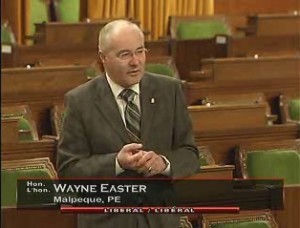 Hon. Wayne Easter (Malpeque, Lib.): Hon. Wayne Easter (Malpeque, Lib.):
Mr. Speaker, I can understand that. There is often quite a lot of fog on the other side in any event, so it is understandable that you could not see him.
I will admit the bill on maintaining heritage lighthouses is a light in the wilderness of conservatism at the moment. The member did a positive thing with his good work.
This is an issue that has been on the go for quite a while. I too want to recognize many of the people who have been involved in this over time, and they were named. One senator, whom I had the opportunity to work with, has passed away and this bill was a passion of his, and I think we have to recognize that.
These heritage lighthouses are part of our history, there is no question about it. The bill is a step in the right direction. I congratulate both members for their initiative in the House in bringing it forward.
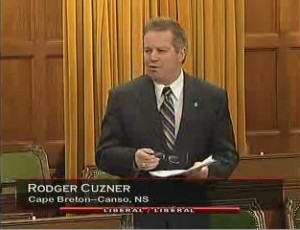 Mr. Rodger Cuzner (Cape Breton—Canso, Lib.): Mr. Rodger Cuzner (Cape Breton—Canso, Lib.):
Mr. Speaker, there seems to be a lot of love in the chamber today. I also join in the throng and the chorus of congratulations. The late Senator Forrestall was a gentleman who was very active on this issue, and he deserves great recognition. The passing of the bill would certainly pay tribute to his efforts, as well as the member for Bruce—Grey—Owen Sound and the member for South Shore—St. Margaret’s who brought this forward in the last Parliament.
It is an important bill. When going through the research on it, it is astounding that we are the only country out of the G-8 that does not have legislation in place for lighthouses. We can look south of the border down through the New England states. Almost 70% of the lighthouses are protected under some type of heritage legislation.
We have over 500 lighthouses in Canada. It is imperative that the time has finally come and, hopefully, we will be able to respond to this.
I also take this opportunity to commend the Nova Scotia Lighthouse Preservation Society. It is a great group. I believe the province of Nova Scotia has more lighthouses than any other province in the country and this group has done so much with advancing and keeping this issue to the fore. Hopefully this will culminate in some success in the next number of months. We will continue to work on that because it is a concern.
Only 3% of Canadian lighthouses now have genuine heritage protection and only 12% have some type of partial protection, and that is a concern.
As I had said, the Nova Scotia Lighthouse Preservation Society is very active. It has reason to be because of the numbers. When we look at properties like Sambro, it is almost 250 years old. The member for Malpeque told me that the current of Minister of Fisheries was there at the official opening of the Sambro lighthouse, although I cannot say that is a fact. The lighthouse at Sambro is a huge tourist draw. When people come to Nova Scotia and spend their summers in there, they tour the coastal communities. They want to see Sambro and experience that trip back in history.
There are a great number of lighthouses in my riding, but the technology has changed. Where we had manned lighthouses, now the technology is on our ships. If we walk into the house of a fishing vessel now, it is like walking into an high-tech IT office, with computers, keyboards, monitors, GPS and screens all over the place. With what they have available to them now, we do not see as many lighthouses. Some have become redundant, as far as their actual function and necessity, because of the navigational aids. Others have become de-staffed and automated, but still provide a very important service to mariners and fishermen alike.
In my riding, Cape George, Cheticamp, Port Hood, Scatari Island and Flint Island all have lighthouses. I will talk about a couple in particular. We have been very fortunate in that some community groups recognize the cultural and historical importance of these lighthouses and have come forward, rolled up their sleeves and taken control over them.
I want to touch on a couple where the community has realized some success. The lighthouse in Mabou Harbour was built in 1884 and protected the coastal steamers. The west side of Cape Breton Island was the only protected harbour. That light was a beacon for safety, a safe harbour for anybody who worked and plied their trade on the west coast of Cape Breton. It was very active as was Mabou Harbour. There is a lobster cannery, which my wife’s grandfather, Herb Hopkins, operated before he took the trade down to Port Morien and Glace Bay.
In 1998 a group from that community got involved and took charge of the lighthouse project. There has even been a great resurgence of interest in the property. We invested some money in the harbour authority and upgraded it four years ago. It has really taken on some energy and the community has rallied around it. It has become more of a destination and a spot for tourists to stop as they go through the Mabou area to the Red Shoe and Strathsbay Place and all those great tourist opportunities on the west side of the island.
I know everybody in the House is familiar with Fortress of Louisbourg. The first lighthouse in Canada was built in Louisbourg in 1734. The current lighthouse was reconstructed in 1923, but the old light lens can be seen at the Louisbourg Marine Museum. There is a very active lighthouse society. In fact, the lighthouse is an incredible spot to visit. I encourage anybody, when they come to Cape Breton, to go past Havenside to the lighthouse on the point facing Louisbourg. Looking out over the historic property of Louisbourg fortress is spectacular. It is something of which every Canadian should be proud. One of the best vantage points is from that lighthouse.
A group has developed a whole trail system along that coast. Ernie Parsons, Rick McCready, Jimmy DeVries and Susan Burke are some of the people who have been involved in this project. It is a spectacular experience to go out to the lighthouse, to view the coastal waters and to hike along the trail. It is a great experience.
The station in Queensport in Guysborough county was established in 1882. The current lighthouse was built in 1937. In 1991 the Department of Transportation identified that it would be finished with it, but the municipality of Guysborough stepped up. It has kept it painted and restored. There is a local foundation there now, Keepers of the Beacon, which continues to do good work on the Queensport lighthouse.
Not all these assets have had great success. There was a lighthouse just outside of Mulgrave in Eddy Point. It was on the eastern side of the Canso Strait, the strait that separates Cape Breton from the mainland. A community group was very interested in taking over operation of the lighthouse, ensuring that the lighthouse was restored and properly maintained. However, the Coast Guard came in 2003 or 2004 and said that it did not have the ability because the legislation was not in place. It was its responsibility to ensure liability was not undertaken by the Department of Fisheries and Oceans, Coast Guard. That lighthouse was dismantled, which was a true tragedy.
I am sure the legislation will prevent those types of losses from our inventory of coastal lighthouses.
Because of the historical importance, the cultural importance and the impact they have on the tourist industry in coastal communities, it is important we continue to be vigilant with lighthouses. Therefore, we will be supporting the legislation.
(1805)
[Translation]
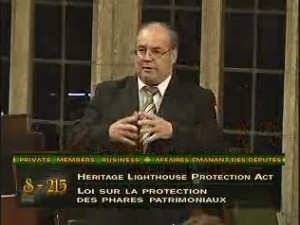 Mr. Mario Laframboise (Argenteuil—Papineau—Mirabel, BQ): Mr. Mario Laframboise (Argenteuil—Papineau—Mirabel, BQ):
Mr. Speaker, it is a pleasure for me to speak to bill S-215, in the name of the Bloc Québécois. We will not join the Liberal and Conservative harmonies, although we would like to have a real policy for the enhancement of heritage lighthouses.
In our view, the problem when a bill comes from the Senate or is a private member’s bill is that there is no budget attached to it. That is the drama in this case. Even though a bill could be adopted to designate heritage lighthouses, if no money is allocated for the enhancement of lighthouses before offering them to groups who could preserve them, there is a problem. The federal government has probably been the worst property owner in Canada. One just has to look at the West Block to understand that the government has not maintained it as it should have.
In my riding, along the Ottawa River, we have the Carillon Canal and the Grenville Canal, two military canals. The Grenville Canal was handed over to the municipality 25 years ago. It would need an investment of $2 million because it is about to collapse. No money is available for that. The canal was returned to the community. Ask the mayor of Grenville if he wants it. He is trying by all means to find the money and he is stuck with a historical canal, a military monument.
In the study done by the Auditor General, she recommended that half the Carillon Canal—one of the two military canals—be buried instead of being maintained. That is obviously what Heritage Canada did. As it did not have the money to maintain the canal, it decided to fill it up with soil so that only the nice part would be visible. The part that needed to be redone was simply buried.
Along with my colleagues, I would like to support this bill. But for us, it is clear that if the necessary funds are not provided, it is impossible. It is that simple. Many of these canals have been damaged by adverse weather, by the wind and by nature. Sometimes, there has been vandalism, as the member said earlier. Because of new technologies, no one lives in these lighthouses any more. As a result, they are in a poor state and the federal government has simply not maintained them. If we wanted to preserve them for heritage reasons, we would first require the necessary sums of money to restore them. Afterward, it might be possible to offer them to organizations, along with the necessary funds to ensure their proper maintenance in the future.
Once again, it is a pleasure for me to represent Quebec because when the Government of Quebec decides to look after its heritage it provides the necessary money, which the federal government has not done. I would have liked to have heard my colleagues, both Conservatives and Liberals, say that they want to provide the funds required for restoration. Otherwise, I will think they know about it and they are a little embarrassed to have taken part in that.
In fact, over the past 100 years, the Liberals and Conservatives have been in power in Canada and they have not provided the money necessary for maintaining our heritage. It is a shame, because these lighthouses really should be preserved. The necessary money really should be provided. We are not able to provide the money to restore them but we are deciding to adopt a bill that creates a process for assigning that task to either organizations or municipalities.
That does create a problem. Many municipalities have refused to accept that responsibility because some lighthouses have been contaminated by the old technology that produced spills. As a result there is contaminated material near the lighthouses.
No municipality would want to take ownership of a lighthouse that was suspected of being on contaminated ground. There must be a restoration program with the necessary funding to decontaminate the soil, where required, and to restore lighthouses that have been damaged by bad weather or vandalism or, quite simply, because the federal government did not look after them.
If this whole principle had been implemented, the Bloc Québécois would have been happy to support the bill. Clearly, we will not fight a huge battle in this regard. We would like the Liberals and the Conservatives to take note of the fact that they have not maintained their heritage lighthouses, in particular, much less other aspects of their heritage.
I repeat: the best example is just two steps away and that is the West Block. It was not until stones started falling off that anyone realized there was a problem. That is the reality.
(1810)
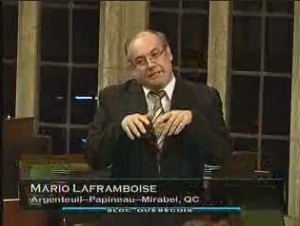 That is how the Conservatives and the Liberals have taken care of their assets over the past 100 years. Clearly, we cannot talk about Bill S-215 here today and say that everything is fine and that we can transfer and protect the equipment and the lighthouses. That is how the Conservatives and the Liberals have taken care of their assets over the past 100 years. Clearly, we cannot talk about Bill S-215 here today and say that everything is fine and that we can transfer and protect the equipment and the lighthouses.
When this equipment is in bad shape, either because a new technology is now used, because people go there less, or because no one takes care of it anymore, we must act responsibly and say that we will implement measures for heritage lighthouses, that a budget will be allocated and that all the equipment will be restored before handing it over to community organizations, municipalities, and the like.
The bill is sponsored by a Conservative member and that is just great. He could have made sure the necessary funding was in place in order to make a nice announcement today that this legislation will indeed be implemented to protect heritage lighthouses, that there will be a budget of so many millions of dollars to restore them and that a procedure and everything needed to restore and protect them thereafter will be established to ensure they remain part of our heritage. We need to make sure that the organizations that take over the lighthouses have the necessary resources to maintain them and do better than the federal government has done in many cases since those lighthouses were built.
It is clear to us that a restoration program is important. Heritage lighthouses must be protected, but this legislation has to come with a program and the necessary funding to restore the lighthouses. When we read this bill and the comments about this legislative measure, it is as though the communities had let them deteriorate. They were the federal government’s property. It is was up to the federal government to maintain them. Then they would not have deteriorated the way they have. They are isolated and the government abandoned them and did not take care of them.
I was listening to the hon. Liberal member tell us that the Department of Fisheries and Oceans has demolished a lighthouse because of concerns. I understand, they did not maintain it and did not want anyone in the community to take it over. If there had been any accidents or injuries, the government or the Department of Fisheries and Oceans would have been sued. I understand them. That is what it has come to with much of this equipment that is in a rather advanced state of disrepair. Some is located near contaminated soil. Nothing has ever been done to remedy these situations.
Again, we hope that one day the necessary budgets will be adopted and that the Conservatives, like the Liberals, will understand that it is all well and good to say in a bill that they will protect heritage lighthouses, but that the necessary funding needs to be in place to restore them before they are turned over to the community to be taken care.
(1815)
The Acting Speaker (Mr. Royal Galipeau):
If there is no other debate, I will recognize the hon. member for Bruce—Grey—Owen Sound for his right of reply. The hon. member has the floor.
Mr. Larry Miller (Bruce—Grey—Owen Sound, CPC):
Mr. Speaker, as a member across the way said, there seems to be a lot of love in the House tonight. On the serious side, it speaks to the fact that this bill is supported right across the country. It is not controversial. This should be done and needs to be done. One thing I want to point out is that there is support from every part of the country, from one side to the other, from every province in the Maritimes, through Quebec, in Ontario where I am from, around the Great Lakes, and right out to the west coast.
There is one thing that I know will make the Bloc member happy, because he talked about the funding aspect of this bill. I have to point out to him that it has been addressed for the first time in I am not sure how long; I will not say for the first time in history but I will say that it is a long time. The minister got money in the budget this year to deal with the issue. We can all debate about whether it is enough, but there is money and I think that is a very positive thing. I thank everyone for their support.
The Acting Speaker (Mr. Royal Galipeau):
The question is on the motion. Is it the pleasure of the House to adopt the motion?
Some hon. members: Agreed.
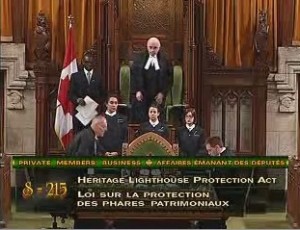 (Motion agreed to, bill read the third time and passed) (Motion agreed to, bill read the third time and passed)
This text is excerpted from the House of Commons Proceedings in HANSARD for Thursday, May 1, 2008
A big thank-you goes out to these parliamentarians who spoke to the bill and to others in the House of Commons and the Senate who have supported the passage of the Lighthouse Protection Bill. Also, a special thankyou goes out to those individuals from all across Canada who worked to lend their voice for support of this bill. |
 Debates of the Senate (Hansard) 2nd Session, 36th Parliament, Volume 138, Issue 58 Thursday, May 18, 2000
Debates of the Senate (Hansard) 2nd Session, 36th Parliament, Volume 138, Issue 58 Thursday, May 18, 2000




